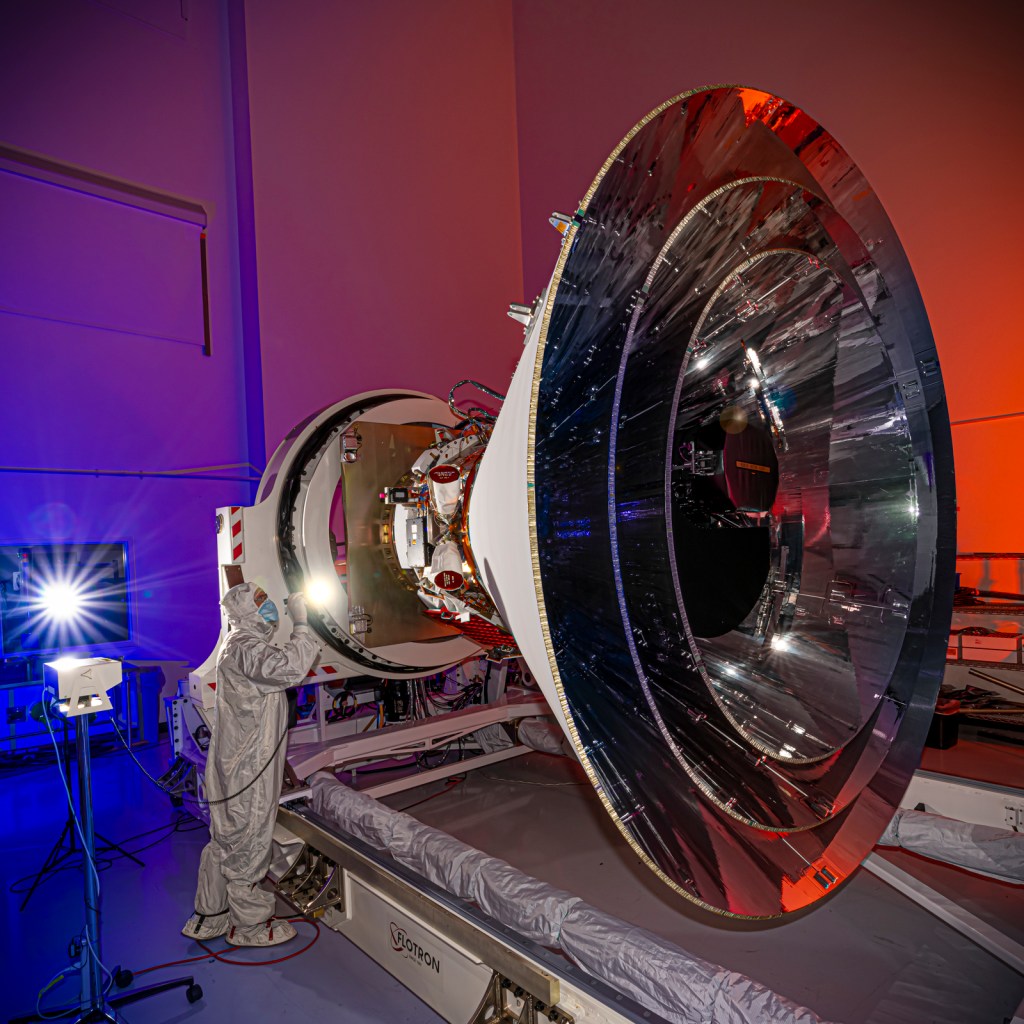OUR SPACE: The most colorful map of the universe
Published 5:00 pm Thursday, December 19, 2024

- This picture shows the SPHEREx observatory in a horizontal position, allowing us to see all three layers of photon shields as well as the telescope. This configuration was used to perform a cover deployment test, as well as a thorough inspection and cleaning of the photon shield edges. In this picture, the telescope soft cover is installed to protect the optics from dust and other foreign objects. The observatory was transported in this orientation to the anechoic chamber used for EMI/EMC testing in late April, before being moved to a vertical position for the test. This picture was taken at BAE Systems, in Boulder CO in mid-April 2024. (BAE Systems, Courtesy NASA/JPL-Caltech)
2024 is drawing to a close, but space exploration never takes a day off. There’s an awful lot of space out there, and of course we can see only a relatively tiny portion of it, being stuck on our own blue marble, at least for the foreseeable future. What we can see, though limited as it may be, is pretty darn spectacular.
When we think of space telescopes, we tend to think of those that bring us those faraway sights to ooh and aah over. Sometimes, those telescopes stare at a small patch of the universe for a long time, teasing out vast numbers of galaxies from the early days of the cosmos.
But what about the big picture? Or — dare we say — the whole picture?
Trending
Enter SPHEREx, a new spacecraft launching in about two months, whose main job it is to document the entire universe as seen from Earth. Imagine yourself at the center of a crystal ball, with everything there is to see in the night sky etched onto its surface. A three-dimensional map, if you will!
SPHEREx, as hinted at by the almost-all-caps name is of course another one of those clever NASA acronyms. It stands for Spectro-Photometer for the History of the Universe, Epoch of Reionization and Ices Explorer, which is quite a mouthful. So let’s unpack this unwieldy moniker and see what it’s all about!
The spectro-photometer is quite simply the main science instrument aboard SPHEREx. It will photograph the universe as seen from Earth in over 100 colors. What we usually think of as colors — the rainbow ones — are really just our brain’s interpretations of various wavelengths of the electromagnetic spectrum. And the portion we can “see” with our grey matter is actually quite small. There are vast stretches of the infrared and ultraviolet (and even more energetic) portions of the spectrum that would have their own colors, if only our brains could process those wavelengths. So those beautiful images we get from the Webb telescope are an interpretation of what those targets might look like, in their very own portion of the infrared spectrum.
SPHEREx will analyze the infrared portion of the light we can see from Earth and split it up into about 100 different sections, each represented by a different color. And it will make those images of the night sky the most colorful thing you can imagine!
The older a beam of light is, the more it is shifted towards the low-energy end of the spectrum, into what we see as red. In simple terms – the more red a galaxy appears, the older its light is and the further away it is. The Epoch of Reionization came about a few hundred million years after the Big Bang, and that’s when the first light in the universe was produced. Yep, it took quite a while before the chemistry was just right for the first stars and galaxies to form and ignite their nuclear furnaces…
One very cool byproduct — pun fully intended — is that SPHEREx will also inventory the amount of water in our own galaxy. Research has shown that much of the water exists in the form of ice, enveloping minuscule dust particles. When enough of those coalesce they might form a planet or moon or asteroid with oceans. Every element has its own unique signature in the spectrum, and when you take pictures of something and analyze the colors with a spectroscope you can find out a lot about what an object is made of. Water is made up of hydrogen and oxygen, so if those two elements show up in your analysis, you can bank on having water there in some form.
Trending
SPHEREx is a quite unusual spacecraft — it looks like someone shuffled together three of those collars they put on dogs after surgery – the often maligned (yet so incredibly useful) “cone of shame.” While we don’t need to worry about the spacecraft licking its unmentionables, we do need to worry about light and heat from the Earth, so the stacked cones serve as reflectors to keep the inside nice and cool and out of the influence of our fair planet, so as not to contaminate the actual image.
SPHEREx will launch atop a SpaceX Falcon-9 rocket, one of the workhorses of the space industry. Its projected mission will be about two years. The launch site will be Vandenberg Space Force Base in California — which is the usual place to get spacecraft into orbit that need to cover the entire planet by means of a polar orbit. The Jet Propulsion Laboratory in Pasadena, California (home base of Yours Truly) will operate the mission, and it was also responsible for systems engineering and integration.
Learn more about SPHEREx at https://spherex.caltech.edu/ .
—Beate Czogalla is the Professor of Theater Design in the Department of Theatre and Dance at Georgia College & State University. She has had a lifelong interest in space exploration and has been a Solar System Ambassador for the Jet Propulsion Laboratory/ NASA for many years. She can be reached at our_space2@yahoo.com





